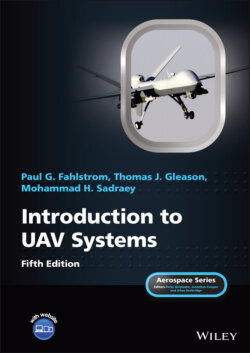Читать книгу Introduction to UAV Systems - Mohammad H. Sadraey - Страница 45
1.6 Predator Family 1.6.1 Predator Development
ОглавлениеRQ‐1 Predator is a long‐endurance, medium‐altitude unmanned aircraft system for surveillance, reconnaissance, and attack missions, designed and manufactured by General Atomics Aeronautical Systems.
The Predator had an unconventional development cycle with origins going back to a project by Abraham E. Karem. He is a pioneer in innovative fixed and rotary‐wing unmanned vehicles and is regarded as one of the founding fathers of UAV technology. Initially, by 1983, a small long‐endurance tactical reconnaissance UAV prototype was developed called the Albatross for the DARPA. Then, by 1988, further development resulted in a more advanced design, the Amber, which was followed by the GNAT 750. Karem’s company (Karem Aircraft, Inc.) and its UAV were soon acquired by General Atomics.
The CIA utilized the GNAT 750 in military operations over Bosnia in 1993 and 1994. The program suffered from a few weaknesses, but it held enough promise that the DOD expressed interest in a larger, more advanced version of the GNAT 750 for medium‐altitude reconnaissance, then designated RQ‐1 Predator. By 1995, it became operational over Bosnia. In parallel, the Air Force saw the Predator as a new tool in tactical reconnaissance with the added benefit of a live satellite data link.
In the late 1990s, Predator’s capability was expanded to include a laser designator to illuminate targets and guide weapons dropped from other aircraft. In 1999, the UAV had its first significant test during Operation Allied Force in Kosovo. By 2000, due to concern over the rising threat of al Qaeda, the Predator was scheduled for arming with the Hellfire laser‐guided missile.
After the September 11, 2001 attacks, the armed Predator become fully operational, and by January 2003, flew 164 missions over Afghanistan. The armed Predator – capable of both reconnaissance and attack missions – has continued to have a pivotal role in combat operations. In 2002, the Air Force adapted a Predator to carry Stinger missiles and attempted an air‐to‐air engagement with an Iraqi MiG‐25, but resulted in the loss of the Predator.
Predator UAVs have been operational since 1995 in support of NATO, UN, and US operations, and as part of Operation Enduring Freedom in Afghanistan and Operation Iraqi Freedom, flying more than 500,000 flight hours. The US Air Force Predator production ended in 2011 with 268 air vehicles manufactured. Hundreds of Predators have been sold to a number of countries including Italy, Spain, France, UK, Australia, Netherlands, Canada, and Germany.
This military UAV has been used in the Balkans, Afghanistan, Iraq, and other global locations. By 2011, the US military had nearly 11,000 UAVs on their inventory, including hundreds of Predators. The Predator was retired in 2018. The Predator‐series family encompasses MQ‐1 Predator, MQ‐1C Gray Eagle, MQ‐9 Reaper (Predator B), MQ‐9B SkyGuardian, and Predator C Avenger.
